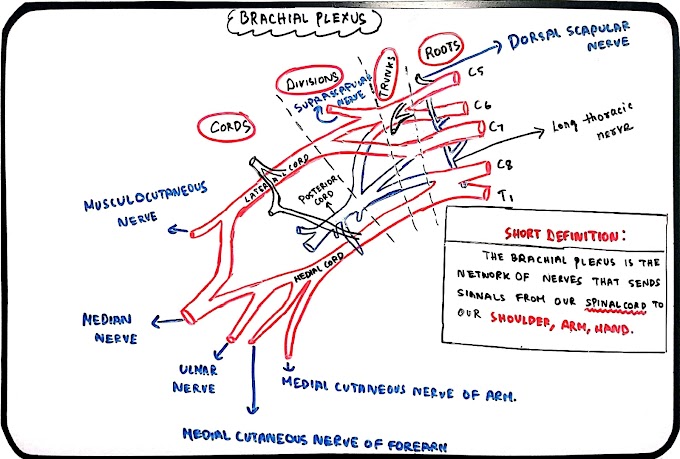In this article you
will learn the basic parts of the brain.
So, now starting
with the brainstem,
It consists of
the midbrain, (superior)
Pons(middle)
Medulla
oblongata(inferior).
The medulla
oblongata ends at the foramen magnum where
the spinal cord begins.
Midbrain:
The midbrain contains two pipe-like
structures on the anterior side. That is called cerebral peduncles. They connect the cerebrum to brain stem.
At the back of the midbrain, we can see the 4
bumps. That is called corpora quadrigemina. It
is divided into superior colliculi and inferior
colliculi.
These superior and inferior colliculi form the tectum
(roof of the midbrain).
Nuclei: A
collection of cell bodies in the Central nervous system.
Ganglion: A
collection of cell bodies in the peripheral nervous system.
We’ve got many
nuclei in the brainstem responsible for heart rate, blood pressure,
respiration, level of consciousness, wakefulness, and arousal.
Pons:
The
largest part of the brain stem is Pons. It is nothing but group of nerve fibers
which connects the cerebrum and the cerebellum. (Pons - Latin - bridge)
Medulla oblongata:
The
medulla oblongata connects the spinal cord to the Pons. So, it plays an
important role in dealing with autonomic activities like respiration and heartbeat.
Cerebellum: (little
brain)
Just behind the brainstem and is responsible for balance, motor
control, coordination, muscle tone.
it contains two lobes. It is connected to the brain stem.
Prosencephalon > Forebrain
(front part of the brain) > Telencephalon + Diencephalon
Telencephalon:
It consists of Cerebral cortex
of both hemispheres, hippocampus, basal ganglia, and olfactory bulb.
Diencephalon:
It
consists of the thalamus (oval-shaped) (two
lobes of thalami are joined in the middle via the inter-thalamic
adhesion), hypothalamus (a small
structure anteroinferior to the thalamus, the Pineal
gland (at the back, between the superior colliculi) and also the
posterior part of the Pituitary gland.
Mesencephalon > Midbrain
Rhombencephalon > Hindbrain
> Medulla oblongata + Pons + Cerebellum
Thalamus:
It acts as the switchboard or gateway or relay to the cerebral cortex. It sends
and receives signals from the cerebral cortex via thalamocortical
loops and lots of reciprocal connections. It is important for
coordinating information from various sensory systems, sleep, and wakefulness.
It’s also connected to the basal ganglia.
Cerebral
hemispheres:
It consists of the outer cerebral cortex.
It consists of 6 layers of gray matter.
The inner part of the cerebral hemisphere consists of white matter which is called centrum semiovale.
Cortex:
The outer gray
matter of the cerebral hemisphere and consists of 6 layers.
The Neocortex is
where the cortex has 6 layers. The neocortex is responsible for language and conscious thought. This is the
evolutionarily newest part.
The spots where the
cortex contains less than six layers are
called the allocortex.
Allocortex:
subdivided into Archicortex and paleocortex.
From the outside
view of the cerebral hemisphere, we can see the ridges and grooves. The ridges
are called gyri and grooves are called
the sulcus.
The central sulcus and lateral sulcus are the main sulci that divide the
brain into functionally important parts.
We have four lobes (frontal
lobe, occipital lobe, temporal lobe, and parietal lobe) of the brain separated
by a different sulcus.
A rough overview of
the functions of the lobes of the brain:
Frontal
lobe- decision making,
problem-solving, and planning
Temporal
lobe- language,
emotions, memory, hearing
Parietal
lobe- receives and
processes the sensory information.
Occipital
lobe- vision.













0 Comments